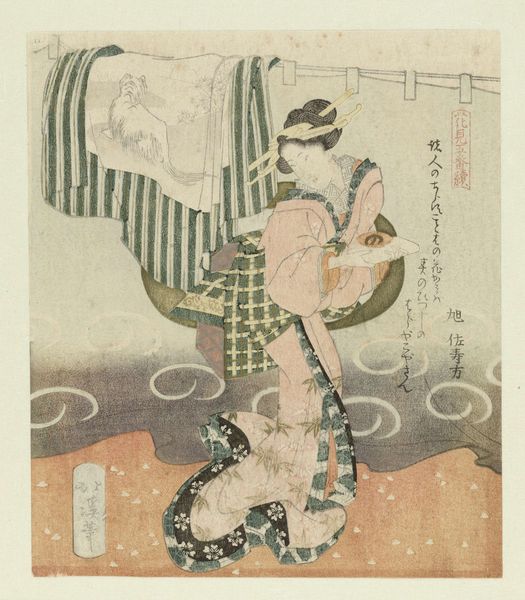
Courtesan Standing by Screen and Bed c. 1768 - 1769
0:00
0:00
#
portrait
#
ink painting
# print
#
asian-art
#
ukiyo-e
#
japan
#
nude
Dimensions: 26 5/8 × 4 5/8 in.
Copyright: Public Domain
Editor: Here we have Suzuki Harunobu’s “Courtesan Standing by Screen and Bed,” a Japanese woodblock print from around 1768 or 1769. I’m really struck by the stillness of the figure and the voyeuristic quality. What do you see in this piece, in terms of symbolism? Curator: Indeed. There’s a careful dance here, a suggestion of the everyday elevated through symbol. Consider the partially exposed body – what does it tell us about the negotiation of desire in Edo-period Japan? The screen behind, almost like a distorted mirror, could reflect both the real world and an idealized vision. Does this resonate with how people perceive themselves in the context of societal expectations? Editor: That's interesting. I hadn't thought about the screen as a distorting mirror, but that makes sense, given how her body is presented, or rather, partially hidden. It is as though there is so much that cannot be displayed, not in this very moment and in that particular time period. Curator: Precisely. And note the bed. Not overtly sexual, yet undeniably present. In this context, what might it symbolize, beyond its functional purpose? Consider the role of dreams, fantasies, or even societal roles assigned to women during that period. Editor: Perhaps a cage? This helps unpack more of the painting. Curator: Or maybe even just another liminal space where different kinds of projections and repressions can happen. Consider the colors, too. How do they guide your eye? The muted palette and the way in which all the planes compress make it both alluring and simultaneously quite withdrawn, as if looking at it from a peephole. Editor: It's really helpful to break it down like this, to see the push and pull between reveal and concealment, to note not only what it is, but what it could be. Curator: Indeed, we begin to see it as less of an individual portrait and more as an encoded representation of womanhood during that period.
Comments
No comments
Be the first to comment and join the conversation on the ultimate creative platform.













